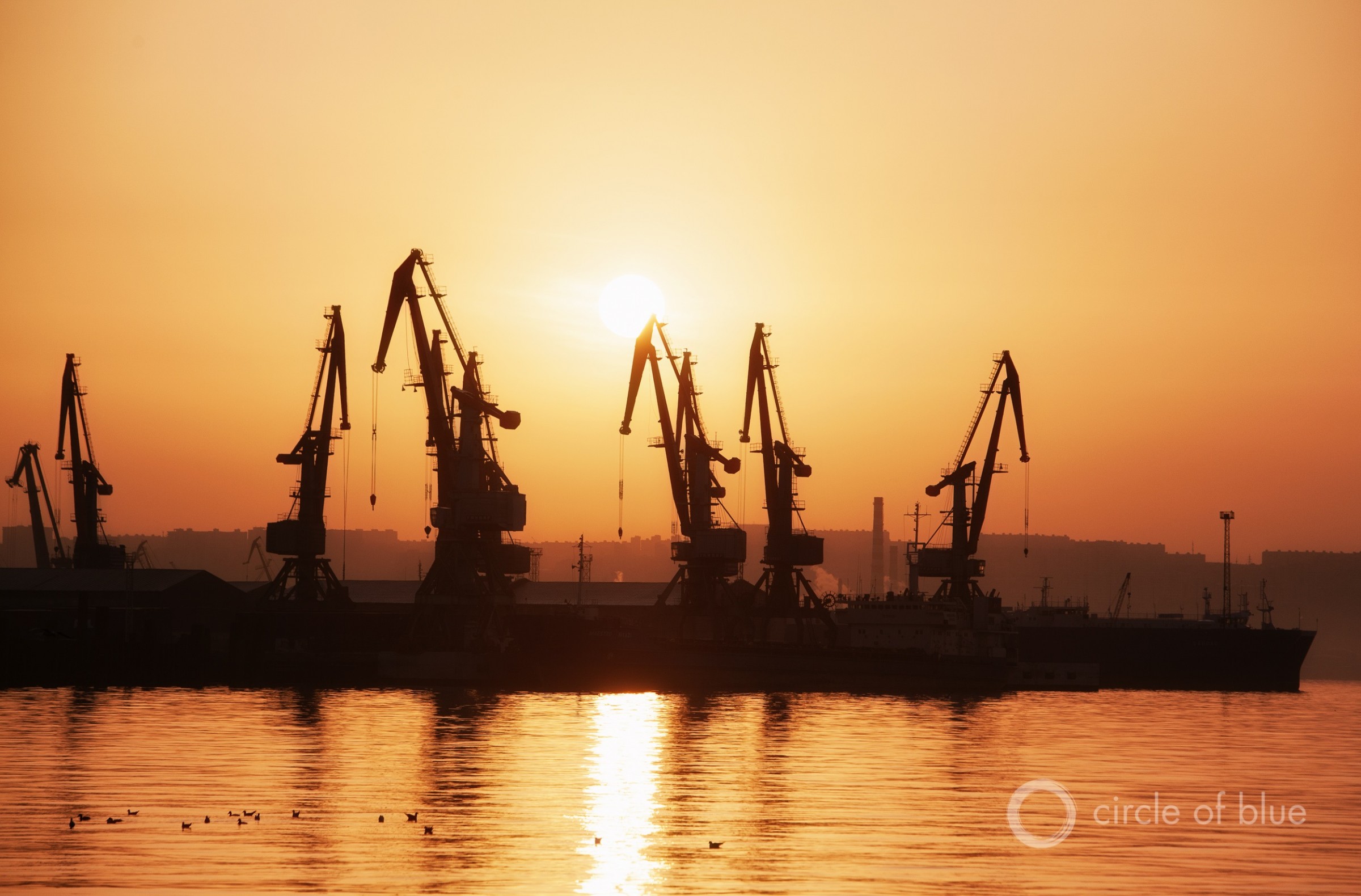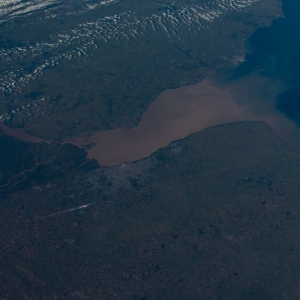The Stream, June 6, 2023: Evacuations and Flooding in Southern Ukraine After Blast Hits Dam

Baku, capital of Azerbaijan, sits on the western shores of the Caspian Sea. Photo © J. Carl Ganter/Circle of Blue
YOUR GLOBAL RUNDOWN
- With a severely dry El Niño season forecast, leaders in Indonesia are bracing for forest fires, poor harvests, and groundwater shortages.
- Nearly a decade after requiring large buildings to install water recycling systems, San Francisco is emerging as a leader in reuse implementation.
- Hotter summers and a loss of frost have water monitors in British Columbia concerned for the province’s drought resilience and wildlife populations.
- An explosion at a hydroelectric plant in southern Ukraine placed thousands of people at risk of massive flooding.
Iran is using the Caspian Sea, the world’s largest inland body of water and an unpoliceable zone, to ship arms to Russia in support of their Ukraine invasion.
“In terms of international law, you’re not going to have anyone there on your side. In terms of political will to do something risk tolerant and using a local actor, we also are not going to have anyone there.” — Benham Ben Taleblu, a senior fellow at the Foundation for Defense of Democracies in Washington.
The Caspian Sea has become a weapons highway, Semafor reports, with Iran using the Caspian to ship arms to Russia in support of their Ukraine invasion. Neither American nor NATO forces are able to police these waters without the support of Azerbaijan, Kazakhstan, and Turkmenistan. But these governments are not interested in enforcing sanctions and intercepting shipments. In April, the Wall Street Journal reported that “30,000 artillery shells and a million rounds of ammunition” were ferried from Iran to Russia over the past six months, per Semafor.
This use of the Caspian Sea, Semafor reports, is “the most physical manifestation” of how “the war in Ukraine is accelerating a splintering between Western and Eastern economies, with Russia increasingly shielding itself behind China, Iran, and the former Soviet states.”
Sometimes referred to as the world’s largest lake, the Caspian Sea is one-third as saline as ocean water, though it is heavily diluted with freshwater from the 130 rivers which flow into it, most notably the Volga. While its water cannot be consumed without desalination — an expensive commitment its neighboring countries including Iran, Turkmenistan, and Kazakhstan are considering as water shortages in the region continue — the Caspian has been an agricultural and economic pillar for generations.
Inland, the larger Caspian basin shelters a large network of wetland ecosystems, remaining a crucial hotspot for migratory birds and carbon-sequestering, protected marshes and swamps.
— Christian Thorsberg, Interim Stream Editor
Recent WaterNews from Circle of Blue
- Hotspots H2O: Failing Rains in Darfur Foster Conflict and Displacement — An enduring water crisis continues to inflict tension between crop farmers and herders in the embattled territory.
- In Iowa, a Tale of Politics, Power, and Contaminated Water — Lawmakers silence Chris Jones, a prominent University of Iowa water quality researcher.
The Lead
Dozens of communities in southern Ukraine, some of which are Russian-occupied, are at risk of severe flooding following a blast at the Kakhovka hydroelectric power plant, the Washington Post reports. The strike hit a crucial dam, one of the main suppliers of freshwater for the Crimea region. Because of its importance, Russian forces seized the dam on the first day of their invasion last year.
Ukrainian officials have called the damage “irreparable,” the Post reports, and that “the full weight of water currently held in the Kakhovka reservoir could spill out within the next four days.” Also as a result of the blast, about 450 tons of oil has spilled into the adjacent Dnieper River, catalyzing what officials are classifying as an ecological crisis.
In the lowest-elevation areas around the Dnieper River and the struck dam, reports indicate that water has overflowed the shoreline by nearly a third of a mile. In other settlements, water levels have risen by about 16 feet. In the Kherson region, close to 16,000 people across 80 settlements are in danger of critical flooding; more than 12,000 households are without power.
This Week’s Top Water Stories, Told In Numbers
30
Percent, at most, of rainfall expected this summer in Indonesia, compared to its seasonal average, Reuters reports. Dwikorita Karnawati, the head of Indonesia’s meteorological, climatological, and geophysics agency, told reporters this week that the country’s main islands will likely experience severe drought from June through September, a consequence of a dry El Niño weather pattern. Rice and palm oil harvests are expected to dip, groundwater reserves will shrink, and forest fires are likely. In 2019, when Indonesia was last inundated with widespread fires, the country experienced economic losses of $5.2 billion.
43
Fewer days with frost on the ground each year projected in British Columbia by 2050, compared to recent averages, Sierra Magazine reports. Combined with forecasted temperature spikes, researchers are concerned that the province’s groundwater and streams will continue to disappear in the summer months — a phenomenon that has already led to massive fish die-offs, water shortages, and a loss of drought resilience.
On the Radar
Eight years after passing a law requiring “all new buildings more than 100,000 square feet to have on-site recycling systems,” San Francisco is at the forefront of centralized water reuse technologies, Yale 360 reports. Thus far, six blackwater — water from toilets, kitchen sinks, and dishwashers — and 25 greywater — water from showers, bathroom sinks, tubs, and washing machines — recycling systems are installed within the city, with many more on the way. In total, per Yale 360, the city estimates that 48 reuse systems are currently operating, and 29 more projects are in development. By 2040, the San Francisco Public Utilities Commission estimates the city will recycle 1.3 million gallons of potable water per day.
More Water News
Morocco Drought: Despite an uptick in rain compared to last year, drought and “other adverse climate conditions” are expected to affect poor cereal yields in Morocco, stunting economic growth again, Al-Monitor reports.
Another Arctic Study: A new study published in Nature shows that a key threshold for sea ice loss in the Arctic could be crossed about a decade sooner than expected, the New York Times reports.
Christian Thorsberg is an environmental writer from Chicago. He is passionate about climate and cultural phenomena that often appear slow or invisible, and he examines these themes in his journalism, poetry, and fiction.







Leave a Reply
Want to join the discussion?Feel free to contribute!